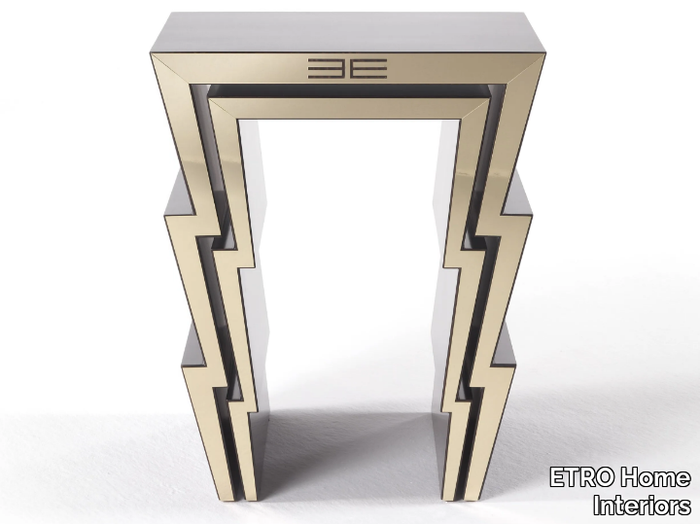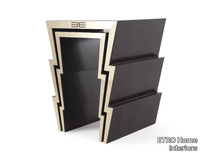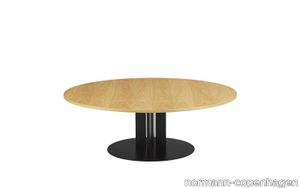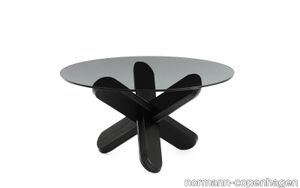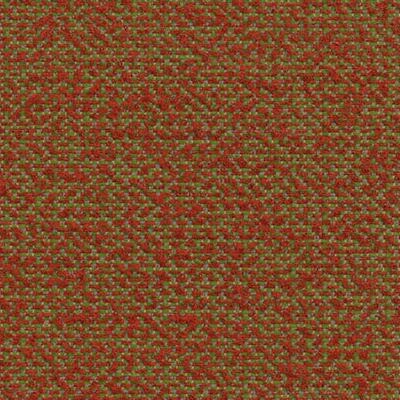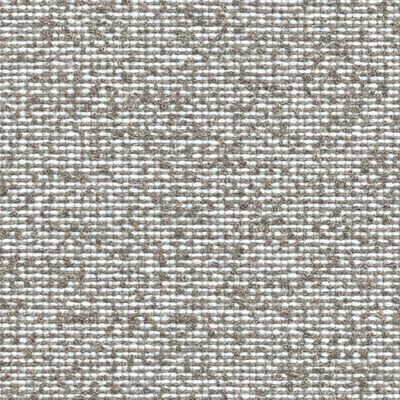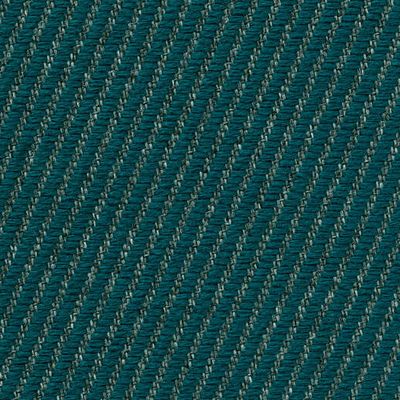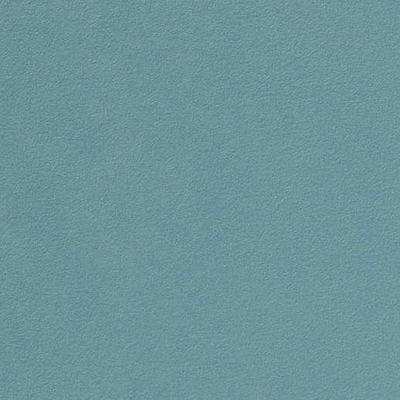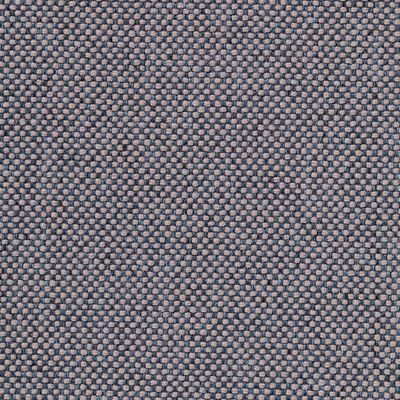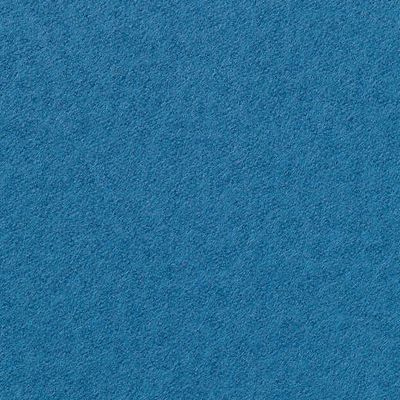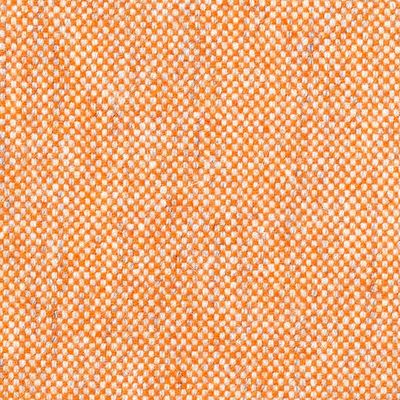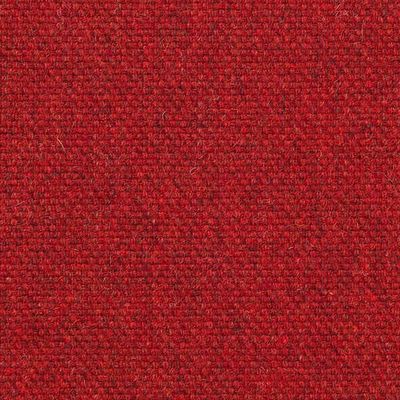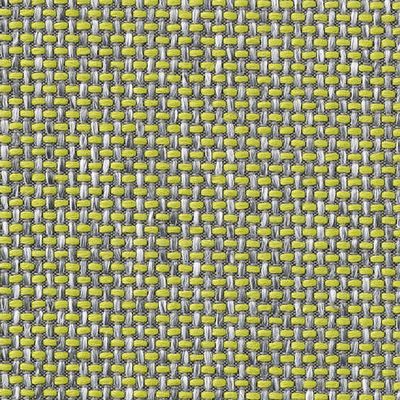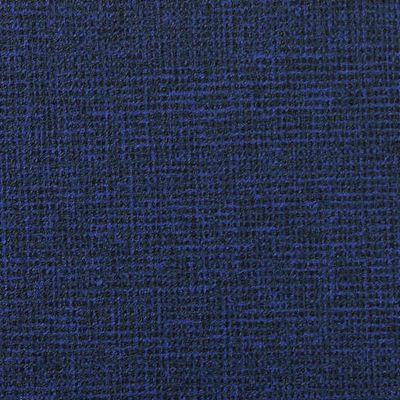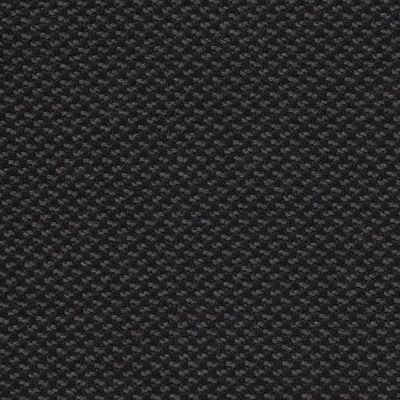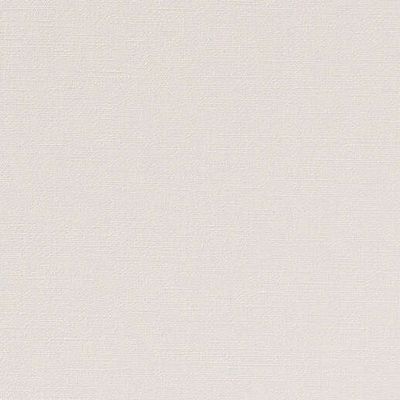ZIGGY - Rectangular eucalyptus side table _ ETRO Home Interiors - 2d files - 3d files
PRODUCT DESCRIPTION
**Product Description:** Crafted from smoked eucalyptus frisé wood, the **Ziggy Side Tables** set features striking zigzag-shaped legs inspired by the bold thunderbolts of Greek mythology—a key theme in Etro’s 2019 collection. With its minimalist yet dramatic design, the piece combines sleek brass accents, evoking the luminous brilliance of Zeus’s lightning, while the subtle incorporation of the Etro logo adds an elegant finishing touch. The set includes a low central table with a glass top, and custom finishes or upholstery options are available upon request through **Etro Home Interiors**. A downloadable 3D file of the product is also provided for design visualization. **Supplier Description:** A division of the **Oniro Group**, **Etro Home Interiors** is an esteemed Italian brand celebrated for its luxurious, artfully crafted furniture and decor, blending timeless elegance with contemporary flair. For more details, visit: [https://etrohomeinteriors.onirogroup.it/](https://etrohomeinteriors.onirogroup.it/)
SUPPLIER: ETRO HOME INTERIORS
COLLECTION: ZIGGY
TYPE: FURNITURE
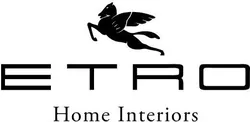
OTHER SUPPLIERS
A wide range of product from near to 3,000 suppliers around the world.



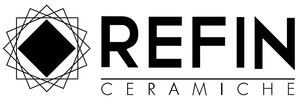
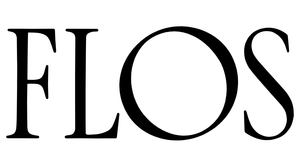

Other Products From This Supplier
A wide range of product from furniture to finishes to meet the desire of all designers.
ZIGGY - Rectangular eucalyptus side table _ ETRO Home Interiors
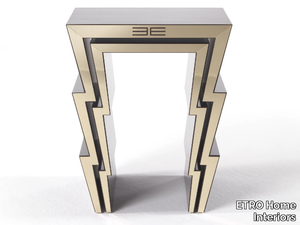
ETRO Home Interiors > Coffee table
**Product Description:** Crafted from smoked eucalyptus frisé wood, the **Ziggy Side Tables** set features striking zigzag-shaped legs inspired by the bold thunderbolts of Greek mythology—a key theme in Etro’s 2019 collection. With its minimalist yet dramatic design, the piece combines sleek brass accents, evoking the luminous brilliance of Zeus’s lightning, while the subtle incorporation of the Etro logo adds an elegant finishing touch. The set includes a low central table with a glass top, and custom finishes or upholstery options are available upon request through **Etro Home Interiors**. A downloadable 3D file of the product is also provided for design visualization. **Supplier Description:** A division of the **Oniro Group**, **Etro Home Interiors** is an esteemed Italian brand celebrated for its luxurious, artfully crafted furniture and decor, blending timeless elegance with contemporary flair. For more details, visit: [https://etrohomeinteriors.onirogroup.it/](https://etrohomeinteriors.onirogroup.it/)
SHAWL - Canvas print _ ETRO Home Interiors

ETRO Home Interiors > Styling
**Product Description:** The *Shawl* is a beautifully printed canvas artwork, elegantly framed in wood with a sophisticated matte black finish, adding a touch of timeless charm to any interior space. A 3D file of this product is available for download, allowing for seamless integration into virtual design projects. **Supplier Description:** ETRO Home Interiors, a prestigious division of the Oniro Group, is celebrated for its exquisite, high-end home decor and furniture, blending Italian craftsmanship with luxurious, contemporary designs. Explore their collections at [https://etrohomeinteriors.onirogroup.it/](https://etrohomeinteriors.onirogroup.it/).
WOODSTOCK.2 - 3 seater tufted nabuk sofa _ ETRO Home Interiors

ETRO Home Interiors > Sofa
Here’s the rephrased and expanded product description, along with a concise supplier overview and mention of the 3D file availability: **Product Description:** The *Woodstock.2* modular sofa, reimagined without feet, features a low-profile, mattress-like design inspired by the "Majlis"—a traditional Arab gathering space. This edition embraces an Afro-inspired aesthetic, with warm fabric hues evoking the savannah and polished brass accents reminiscent of tribal jewelry. Crafted with a matte Dark Wengé wood structure and optional fabric or leather upholstery from the ETRO Home Interiors collection, it offers customizable finishes upon request. A 3D file of the sofa is available for download, enabling seamless integration into design projects. **Supplier Overview:** ETRO Home Interiors, a luxury division of the Oniro Group, is celebrated for its exquisite, high-end furniture and decor, blending traditional craftsmanship with contemporary elegance. Explore their collections at [etrohomeinteriors.onirogroup.it](https://etrohomeinteriors.onirogroup.it/). *(Note: The supplier description is condensed to one sentence while retaining key details about quality, style, and parent company.)*
ZIGGY - Rectangular wood and glass coffee table for living room _ ETRO Home Interiors
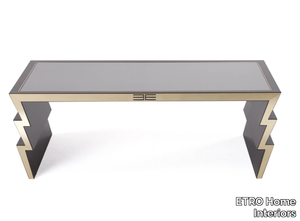
ETRO Home Interiors > Coffee table
**Product Description:** Crafted from smoked frisé eucalyptus wood, the **Ziggy central tables set** features striking zigzag-shaped legs inspired by the bold lines of thunderbolts, echoing mythological themes from the 2019 collection. With its minimalist yet dramatic design, the piece pays homage to the lightning bolts wielded by Zeus in Greek mythology, further accentuated by polished brass profiles and a subtle nod to the Etro logo. The set includes a low central table with a sleek glass top, and custom finishes or upholstery options are available upon request through **Etro Home Interiors**. A downloadable 3D file of the product is also provided for design visualization. **Supplier Description:** **Etro Home Interiors**, a prestigious division of the Oniro Group, is celebrated for its luxurious, high-end furniture and decor, blending Italian craftsmanship with timeless elegance. Explore their collections at [https://etrohomeinteriors.onirogroup.it/](https://etrohomeinteriors.onirogroup.it/).
WOODSTOCK.2 - Tufted modular nabuk sofa _ ETRO Home Interiors
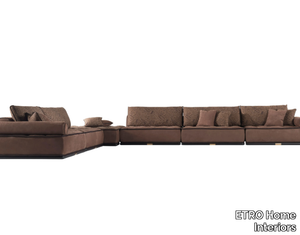
ETRO Home Interiors > Sofa
Here’s the rephrased and expanded product description, along with a concise supplier overview and mention of the 3D file: **Product Description:** The *Woodstock.2* sofa, reimagined in a modular, footless design, features a mattress-like silhouette inspired by the "Majlis"—a traditional Arab gathering space. This piece blends Afro-inspired elements from the 2019 collection, including warm, savannah-hued fabrics and polished brass accents reminiscent of African tribal jewelry. Crafted with a matte Dark Wengé wood structure and brass detailing, it offers upholstery options in select fabrics or leather, with custom finishes available through ETRO Home Interiors. A downloadable 3D file of the sofa is also provided for design planning. **Supplier Overview:** ETRO Home Interiors, a luxury division of the Oniro Group, is celebrated for its exquisite, Italian-crafted furniture and decor, merging timeless elegance with contemporary artistry. Explore their collections at [etrohomeinteriors.onirogroup.it](https://etrohomeinteriors.onirogroup.it/). *(Note: The supplier description is condensed to one sentence as requested, focusing on key brand attributes.)*
TIBESTI - Eucalyptus sideboard with doors _ ETRO Home Interiors
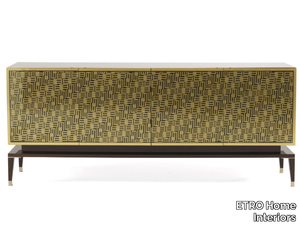
ETRO Home Interiors > Cabinet
**Product Description:** The *Tibesti* is a stunning Deco-inspired sideboard from ETRO Home Interiors, featuring exquisite brass inlays with a pattern that elegantly incorporates the "E," the initial of the Etro logo. Crafted from luxurious smoked eucalyptus frisé wood, this piece showcases a glossy veneer finish on its legs, base, doors, and sides, with polished brass accents enhancing its refined details. The doors are adorned with full or partial brass inlays, adding a touch of opulence. Custom finishes and upholstery options are available upon request from the ETRO Home Interiors collection. A downloadable 3D file of the Tibesti is also provided for design visualization. **Supplier Description:** ETRO Home Interiors, a prestigious division of the Oniro Group, is celebrated for its high-end, artfully crafted furniture and decor, blending timeless elegance with contemporary design. Explore their collections at [https://etrohomeinteriors.onirogroup.it/](https://etrohomeinteriors.onirogroup.it/).
SAMARCANDA - Upholstered round fabric and nabuk pouf _ ETRO Home Interiors
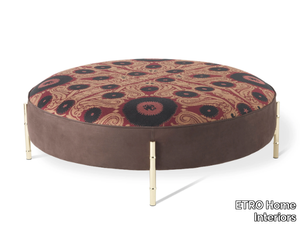
ETRO Home Interiors > Pouf
The **Samarcanda pouf** is a stylish and adaptable furniture piece, available in two distinct shapes and sizes to seamlessly blend into any setting. Featuring bamboo cane-inspired legs—crafted from brass with a polished or brushed dark bronze finish—this pouf combines natural elements with refined elegance. The upholstery, available in luxurious fabrics or leather from the **Etro Home Interiors** collection, adds an ethnic-inspired charm, while the structure is built with multilayer wood and high-density polyurethane foam for durability and comfort. A 3D file of the product is available for download, allowing for easy visualization and planning. Custom finishes and upholstery options are also available upon request. **Supplier Description:** *Etro Home Interiors*, a prestigious division of the Oniro Group, is celebrated for its exquisite, high-end furniture and decor, blending traditional craftsmanship with contemporary design. For more details, visit: [Etro Home Interiors](https://etrohomeinteriors.onirogroup.it/).
SAMARCANDA - Low triangular eucalyptus coffee table _ ETRO Home Interiors
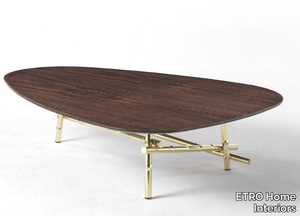
ETRO Home Interiors > Coffee table
**Product Description:** The *Samarcanda* central table is an elegant and evocative piece of furniture, featuring a wooden top with warm, desert-inspired tones that evoke the allure of distant lands. Its dynamic design contrasts beautifully with the base—a sculptural twist of bamboo canes, transforming natural elements into refined artistry that adds lightness and sophistication to any space. Perfect as a standalone piece or paired with matching side tables from the same collection, the *Samarcanda* allows for customizable compositions to suit any interior. The structure is crafted from brass, available in polished or brushed dark bronze finishes, with legs shaped like bamboo canes through a meticulous handcrafted metalworking process. The top can be customized with luxurious marble or onyx from the collection, or with multilayer wood in rich finishes like Dark Wengé dyed Carbalho veneer or Smoked Eucalyptus Frisé veneer. Additional finishes and upholstery options are available upon request from *ETRO Home Interiors*. A downloadable 3D file of the product is also available for design planning. **Supplier Description:** *ETRO Home Interiors*, a prestigious division of the *Oniro Group*, is celebrated for its exquisite, high-end furniture and decor, blending Italian craftsmanship with timeless elegance.
RICHAT - Round wall-mounted mirror with wooden frame _ ETRO Home Interiors
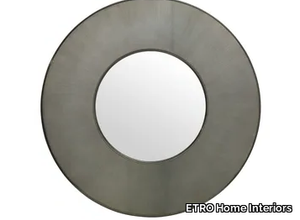
ETRO Home Interiors > Accessories
**Product Description:** The Richat mirror combines essential elegance with profound symbolism, its spherical shape serving as a striking focal point that enhances any wall with sophistication and artistic flair. Crafted from lacquered MDF in a luxurious Patinated Gold Liquid Metal finish, it is precision-made using advanced numeric control technology and features a natural mirror surface. A downloadable 3D file of the product is available for visualization. For more details, visit **RICHAT by ETRO Home Interiors**. **Supplier Description:** ETRO Home Interiors, a premium division of the Oniro Group, is celebrated for its exquisite, high-end furniture and decor, blending timeless Italian craftsmanship with contemporary design. Explore their collections at [https://etrohomeinteriors.onirogroup.it/](https://etrohomeinteriors.onirogroup.it/).
PERSEUS - Wall-mounted mirror with wooden frame _ ETRO Home Interiors
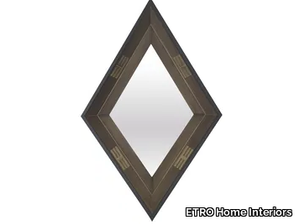
ETRO Home Interiors > Accessories
**Product Description:** The Perseus mirror features a striking geometric design, blending elegance with modern artistry. Its structure is crafted from glossy dark Wengé wood, complemented by a frame in brushed dark bronze lacquered wood and exquisite polished brass detailing. The bevelled natural mirror enhances its refined appeal, making it a sophisticated statement piece for any interior space. A downloadable 3D file of the mirror is available for visualization and planning purposes. **Supplier Description:** ETRO Home Interiors, a prestigious division of the Oniro Group, is celebrated for its luxurious, high-end furniture and decor, combining Italian craftsmanship with timeless elegance. Explore their collections at [https://etrohomeinteriors.onirogroup.it/](https://etrohomeinteriors.onirogroup.it/).
SAMARCANDA - Round Tobacco Brown marble coffee table _ ETRO Home Interiors
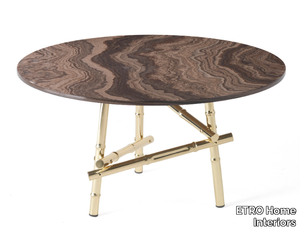
ETRO Home Interiors > Coffee table
**Product Description:** The Samarcanda side tables are elegant and evocative pieces of furniture, featuring marble or onyx tops with warm, spotted motifs that evoke the allure of arid deserts and distant lands. This striking design contrasts beautifully with the base, crafted from twisted bamboo-shaped brass legs, achieved through a handcrafted hot metalworking process. The interplay of natural and luxurious materials adds a dynamic yet refined touch to any space. These tables can be used individually or paired with the central table from the same collection for a customized composition. Available in polished brass or brushed dark bronze finishes, the tops also come in multilayer wood with Dark Wengé or Smoked Eucalyptus Frisé veneers. Additional finishes and upholstery options are available upon request from **ETRO Home Interiors**, a prestigious Italian design house renowned for its luxurious and artistic home decor. A downloadable 3D file of the product is available for design planning. *(Supplier description condensed as requested: ETRO Home Interiors, part of the Oniro Group, is a celebrated Italian brand known for its high-end furniture and decor, blending traditional craftsmanship with contemporary elegance.)*
NUBIA - Upholstered nabuk and fabric armchair with armrests _ ETRO Home Interiors
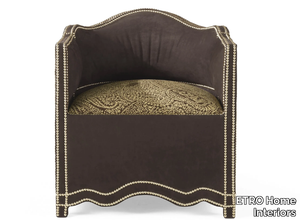
ETRO Home Interiors > Armchair
**Nubia** is a striking armchair rich in symbolism and cultural references, blending bold geometry with timeless elegance. Its studded silhouette draws inspiration from the shapes and warm, earthy tones of traditional African shields, while the intricate paisley-patterned fabric reflects the iconic heritage of the Etro brand—where the sinuous palm motif in cashmere has become a hallmark of its design legacy. Crafted with a sturdy wooden frame and high-density foam, the armchair is upholstered in premium fabric or leather from Etro’s exclusive collection, with optional ornamental golden nails for added sophistication. A 3D file of the product is available for download, allowing for seamless integration into design visualizations. **Supplier Description:** ETRO Home Interiors, a distinguished name under the Oniro Group, is celebrated for its luxurious, artfully crafted furniture and decor, embodying Italian elegance and global design influences. For more details, visit [ETRO Home Interiors](https://etrohomeinteriors.onirogroup.it/).
MCKENZIE - Stained glass pendant lamp _ ETRO Home Interiors
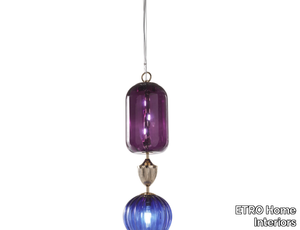
ETRO Home Interiors > Ceiling lamp
The McKenzie pendant lamp features elegant modules crafted from violet and blue glass, complemented by gold-finished metal elements and a matching gold ceiling rose. For those seeking customization, additional finishes and upholstery options are available upon request through the Etro Home Interiors collection. A downloadable 3D file of the lamp is also provided for detailed visualization. Etro Home Interiors, a prestigious division of the Oniro Group, is celebrated for its luxurious and artfully designed furniture, lighting, and decor, blending timeless Italian craftsmanship with contemporary elegance. Explore their collections at [https://etrohomeinteriors.onirogroup.it/](https://etrohomeinteriors.onirogroup.it/).
MERIAM - Upholstered round nabuk pouf _ ETRO Home Interiors
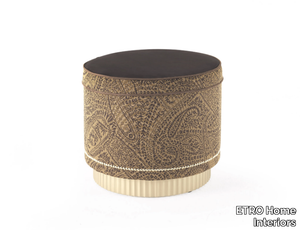
ETRO Home Interiors > Pouf
**Product Description:** The *Meriam* pouf combines elegance and comfort with a sturdy wooden frame, plush polyurethane foam padding, and a sophisticated blend of fabrics and leather. Its sides are upholstered in *Zulu* fabric (color: Tobacco), while the seat features luxurious *Nuuk* nubuck leather (color: Brown). The piping is accented with *Nuuk* nubuck leather (color: Nut), complemented by ornamental golden nails along the base. The pleated bottom is crafted from gold-lacquered wood, adding a refined touch. Custom finishes and upholstery options are available upon request from *ETRO Home Interiors*. A downloadable 3D file of the product is also provided for design visualization. **Supplier Description:** *ETRO Home Interiors*, a prestigious division of the *Oniro Group*, is celebrated for its exquisite, high-end furniture and decor, blending Italian craftsmanship with timeless elegance. Explore their collections at [etrohomeinteriors.onirogroup.it](https://etrohomeinteriors.onirogroup.it/).
KYOTO - Glass pendant lamp _ ETRO Home Interiors
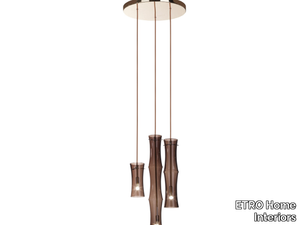
ETRO Home Interiors > Ceiling lamp
The **Kyoto** is an elegant pendant lamp featuring 3 or 9 bamboo-shaped shades crafted from clear bronze glass, complemented by golden fabric cables and a gold-finished metal ceiling rose. For added customization, alternative finishes and upholstery options are available upon request from **ETRO Home Interiors**, a prestigious Italian design house renowned for its luxurious and artistic home decor collections. A downloadable 3D file of the Kyoto lamp is also available for design visualization. Explore more at [ETRO Home Interiors' website](https://etrohomeinteriors.onirogroup.it/).
MCKENZIE - Satin glass pendant lamp _ ETRO Home Interiors

ETRO Home Interiors > Ceiling lamp
**Product Description:** The McKenzie pendant lamp features elegant modules crafted from white frosted glass, accented with alternating metal elements in a luxurious gold finish, complemented by a matching gold metal ceiling rose. Custom finishes and upholstery options are available upon request through the distinguished **ETRO Home Interiors** collection. A downloadable 3D file of the product is also provided for design visualization. For more details, visit the manufacturer’s page on **MCKENZIE ETRO Home Interiors**. **Supplier Description:** **ETRO Home Interiors**, a premium division of the Oniro Group, is celebrated for its exquisite, high-end furniture and decor, blending timeless Italian craftsmanship with contemporary elegance. Explore their collections at [https://etrohomeinteriors.onirogroup.it/](https://etrohomeinteriors.onirogroup.it/).
KLEE - Low eucalyptus TV holder with drawers _ ETRO Home Interiors
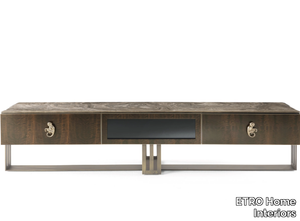
ETRO Home Interiors > Cabinet
**Product Description:** The *Klee* is a stunning and versatile piece that perfectly embodies the distinctive style of Etro Home Interiors, blending luxurious materials and artistic design. Its structure features patinated bronze metal, while the top, sides, and drawers are crafted from either dark wengé dyed carvalho veneer or smoked eucalyptus frisé veneer, adding warmth and sophistication. The design pays homage to the brand’s identity with subtle references to the Etro logo’s initial letter. A brushed dark bronze metal base provides a striking contrast, while the central bronzed glass door and polished brass decorative handles—including playful monkey motifs—add refined elegance. Inside, the drawers are lined with soft microfiber for a premium touch, and an optional marble top from the collection can further elevate its opulence. Custom finishes and upholstery are available upon request, ensuring a personalized design. For added convenience, a 3D file of the product is available for download, allowing for seamless integration into design plans. **Supplier Description:** Etro Home Interiors, a prestigious division of the Oniro Group, is celebrated for its exquisite, high-end furniture and decor, combining Italian craftsmanship with timeless elegance. Explore more at: [https://etrohomeinteriors.onirogroup.it/](https://etrohomeinteriors.onirogroup.it/)
KLEE - Round eucalyptus table with Lazy Susan _ ETRO Home Interiors
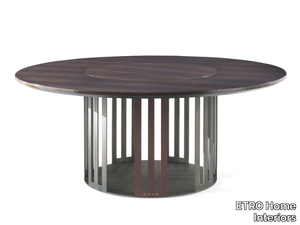
ETRO Home Interiors > Table
**Product Description:** The **Klee Round Dining Table** is a masterpiece of sculptural elegance, blending refined craftsmanship with distinctive design. Its striking base features a hand-finished multilayer treatment in the signature "E" shape—a hallmark of the Klee line—accented by warm Cherry Red varnished details. The table’s scenic structure harmonizes beautifully with the rich, dark brown Carbalho-dyed matt top, exuding sophistication. A wooden Lazy Susan from the **ETRO Home Interiors** collection complements the table, adding functionality to its artistic appeal. Available with a glass top or multilayer wood in finishes like Dark Wengé or Smoked Eucalyptus Frisé, the table also offers customization options upon request. For those seeking inspiration, a **3D file of the product is available for download**, allowing for seamless integration into design plans. **Supplier Description:** ETRO Home Interiors, a prestigious division of the Oniro Group, is celebrated for its luxurious, artisanal furniture and decor, blending timeless Italian craftsmanship with contemporary elegance. Explore their collections at [etrohomeinteriors.onirogroup.it](https://etrohomeinteriors.onirogroup.it/).
KLEE - Upholstered round fabric pouf _ ETRO Home Interiors
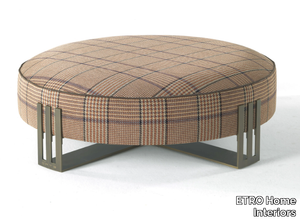
ETRO Home Interiors > Pouf
**Product Description:** The **Klee pouf** by Etro Home Interiors is a versatile and compact piece that beautifully blends elegance and functionality, embodying the brand’s signature style. Featuring a refined metal structure inspired by Etro’s iconic logo, the pouf showcases a laser-cut aluminum frame with a brushed dark bronze finish, paired with a seat crafted from multilayer wood and high-density polyurethane foam for optimal comfort. Upholstered in luxurious fabrics or leather from the Etro collection, it adds a touch of sophistication to any space. Custom finishes and materials are available upon request. A downloadable 3D file of the product is also provided for design planning. **Supplier Description:** Etro Home Interiors, a prestigious division of the Oniro Group, is celebrated for its exquisite, high-end furniture and decor, blending Italian craftsmanship with timeless elegance. Explore their collections at [https://etrohomeinteriors.onirogroup.it/](https://etrohomeinteriors.onirogroup.it/).
MYTHOS - Wood and glass console table _ ETRO Home Interiors
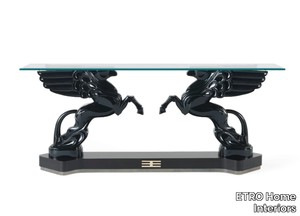
ETRO Home Interiors > Console
**Product Description:** The *Mythos Console* is a breathtaking fusion of mythology and contemporary design, featuring the legendary winged horse, Pegasus—a heraldic symbol of the Etro brand—as its centerpiece. Two dynamically posed Pegasus figures, crafted in glossy black or red lacquer, face each other atop an arrow-shaped base made of matte Dark Wengé wood, their wings elegantly supporting a bevelled clear or bronzed glass top. Brass accents, including the iconic Etro insignia, add a touch of opulence, enhancing the console’s eclectic charm in true Etro Home Interiors style. Custom finishes and upholstery options are available upon request. For those seeking digital customization, a 3D file of the product is available for download. **Supplier Description:** ETRO Home Interiors, a prestigious division of the Oniro Group, is celebrated for its exquisite, high-end furniture and decor, blending timeless elegance with modern artistry. Explore more at: [https://etrohomeinteriors.onirogroup.it/](https://etrohomeinteriors.onirogroup.it/)
KLEE - Rectangular metal adn glass living room table _ ETRO Home Interiors
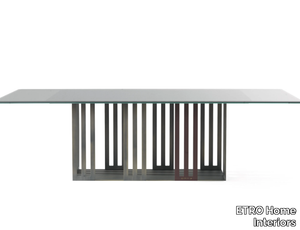
ETRO Home Interiors > Table
Here’s the rephrased and expanded product description, including a concise supplier overview and mention of the 3D file availability: *The Klee dining table embodies sober elegance, featuring an "E"-shaped base—inspired by the initial letter of the Etro logo—crafted from patinated bronze metal with bordeaux accents, paired with a smoked eucalyptus frisé wood top and a matching central lazy susan. Alternatively, the base can be specified in brushed dark bronze aluminum with a cherry-red "E" element, complemented by a glass top (rectangular version only) or multilayer wood tops in dark wengé or smoked eucalyptus frisé veneers. Custom finishes and upholstery options are available upon request through Etro Home Interiors, a prestigious Italian design brand celebrated for its luxurious, artisanal furniture and decor. A downloadable 3D file of the product is also provided for design planning. For further details, visit the manufacturer’s page on Klee by Etro Home Interiors.*
KLEE - Eucalyptus sideboard with doors _ ETRO Home Interiors
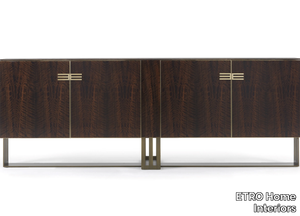
ETRO Home Interiors > Cabinet
The **Klee Sideboard** blends minimalist elegance with luxurious materials, showcasing a refined design with pure, uncluttered lines. The structure is crafted in polished brass or patinated bronze, complemented by smoked eucalyptus frisé veneer on the sides, while the interior features exquisite fabric upholstery from the **Etro Home Interiors** collection. The base boasts a brushed dark bronze metal finish, while the top, sides, and doors are available in dark wengé dyed carvalho veneer or smoked eucalyptus frisé. For an added touch of opulence, an optional marble top from the collection can be selected. Inside, the sideboard is lined with premium fabric and includes clear glass shelves, with polished brass detailing and handles for a sophisticated finish. Custom finishes and upholstery options are available upon request from the **Etro Home Interiors** collection. A downloadable 3D file of the product is also available for design planning. **Supplier Description:** *Etro Home Interiors, a prestigious division of the Oniro Group, is celebrated for its high-end furniture and decor, merging Italian craftsmanship with timeless elegance.* Explore their collections at [https://etrohomeinteriors.onirogroup.it/](https://etrohomeinteriors.onirogroup.it/).
KLEE - Corner velvet sofa _ ETRO Home Interiors
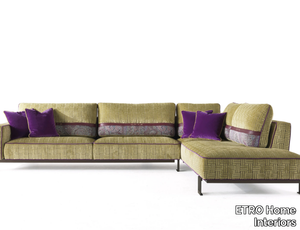
ETRO Home Interiors > Sofa
Here’s your rephrased and expanded product description, including a concise supplier overview and mention of the 3D file: **Product Description:** The **Klee Sofa** blends contemporary elegance with nomadic inspiration, effortlessly adapting to any interior setting. Featuring a striking combination of iconic fabrics from the **Etro Home Interiors** collection, this sofa is accentuated by signature legs inspired by the Etro logo, creating a timeless and distinctive design. Crafted with a **brushed dark bronze metal structure**, it is upholstered in premium fabric from the collection and adorned with matching leather details and **gold ETRO embroidery**. Available as a **standalone piece or sectional**, the Klee Sofa can also be customized with alternative finishes and upholstery upon request. For added convenience, a **3D file of the product is available for download**, allowing for seamless integration into virtual design plans. **Supplier Overview:** **ETRO Home Interiors**, a prestigious division of the Oniro Group, is celebrated for its luxurious, high-end furniture and decor, blending Italian craftsmanship with eclectic, artistic designs. For more details, explore their collection at: [https://etrohomeinteriors.onirogroup.it/](https://etrohomeinteriors.onirogroup.it/).
HIMBA - Rectangular sisal rug _ ETRO Home Interiors
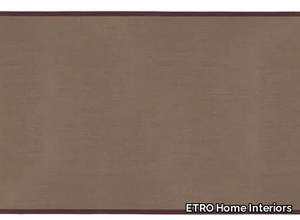
ETRO Home Interiors > Carpet
Here’s a refined and expanded product description, including a concise supplier overview and mention of the 3D file availability: *"The Himba rug combines natural sisal fibers with elegant Bordeaux nubuck leather borders, offering a harmonious blend of texture and sophistication for modern interiors. A 3D file of the product is available for download, allowing for seamless integration into virtual design plans. Crafted by ETRO Home Interiors—a prestigious Italian brand under the Oniro Group—this piece reflects the supplier’s legacy of luxurious, high-end decor, merging timeless craftsmanship with contemporary style."* (Note: I condensed the supplier details to one impactful sentence while retaining key brand differentiators—luxury positioning, Italian heritage, and parent company affiliation.)
KLEE - Upholstered velvet armchair with armrests _ ETRO Home Interiors
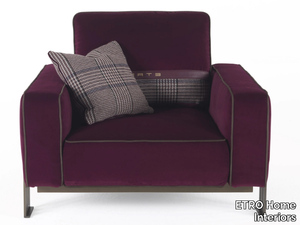
ETRO Home Interiors > Armchair
**Product Description:** The **Klee Armchair** exudes classic charm with its clean, elegant lines, making it a versatile addition to any interior. Its brushed dark bronze metal frame combines with luxurious upholstery options—fabric or leather from the **Etro Home Interiors** collection—such as velvet with Prince of Wales inserts, blending timeless vintage appeal with modern sophistication. Accents of matching leather and delicate **ETRO Gold** embroidery elevate its refined aesthetic. Available as a standalone piece or in sectional configurations, the Klee Armchair can also be customized with alternative finishes and upholstery upon request. A downloadable **3D file** of the product is available for design visualization. **Supplier Description:** **ETRO Home Interiors**, a prestigious division of the **Oniro Group**, is celebrated for its exquisite, high-end furniture and decor, merging Italian craftsmanship with timeless elegance. For more details, visit: [https://etrohomeinteriors.onirogroup.it/](https://etrohomeinteriors.onirogroup.it/)
JANIS - Brass and glass sideboard with doors _ ETRO Home Interiors
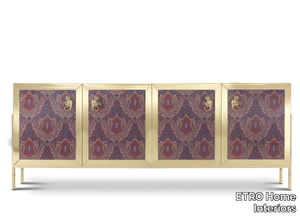
ETRO Home Interiors > Cabinet
**Product Description:** Embodying a nomadic spirit and a sense of wanderlust, this exquisite piece of furniture captures the essence of Etro Home Interiors' signature style. The vibrant Deosai pattern and the playful monkey motif adorning the doors, paired with bamboo cane legs and a luminous patinated bronze structure, create a striking harmony of shapes, colors, and textures. This design reflects the brand’s hallmark refinement, creativity, and bold use of color. Crafted with a base and frames in polished or brushed dark bronze brass, the storage unit features wood lacquered in solid hues from the collection, available in semi-gloss or matte finishes. The doors are made of printed glass from the collection, accented with polished brass frames and details. Custom finishes and upholstery options are available upon request from Etro Home Interiors. For those seeking versatility, a 3D file of this product is available for download. **Supplier Description:** ETRO Home Interiors, a prestigious division of the Oniro Group, is celebrated for its luxurious, artfully crafted furniture and decor, blending traditional elegance with contemporary flair. Explore their collections at [https://etrohomeinteriors.onirogroup.it/](https://etrohomeinteriors.onirogroup.it/).
KRISHNA - Brass and glass side table _ ETRO Home Interiors
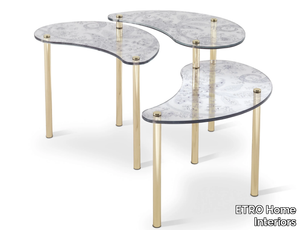
ETRO Home Interiors > Coffee table
Here’s your refined and expanded product description, including a concise supplier overview and mention of the 3D file availability: *The Krishna small table is a harmonious interplay of shapes and transparencies, featuring a refined design with three extra-clear tempered glass tops in varying heights, each elegantly crafted in a symbolic droplet silhouette. Inspired by the paisley motif—an ancient pattern derived from the date palm bud, known as "the tree of life"—the glass surfaces are adorned with delicate decorative elements, adding a touch of artistry. The structure is elevated by polished brass legs, creating a sophisticated balance that complements both classic and contemporary interiors. Tops are made of printed glass from the collection, while the legs are crafted in polished brass. A downloadable 3D file of the product is available for design planning. For further details, refer to the manufacturer, ETRO Home Interiors—a premium Italian design brand under the Oniro Group, celebrated for its luxurious and artistic furniture collections.*
HATHA - Satin glass pendant lamp _ ETRO Home Interiors
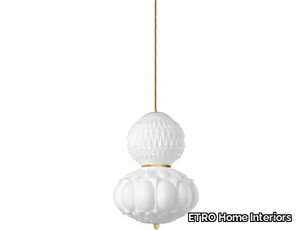
ETRO Home Interiors > Ceiling lamp
Here’s the rephrased and expanded product description with a concise supplier overview and mention of the 3D file: *The Hatha pendant lamp features a sophisticated two-light design with elegant white frost blown glass shades, complemented by a gold-finished metal ceiling rose and a luxurious gold fabric cable. This striking piece effortlessly blends modern aesthetics with timeless elegance, making it a perfect addition to contemporary interiors. A downloadable 3D file of the product is available for visualization and planning. Crafted by ETRO Home Interiors—a premium Italian brand under the Oniro Group, celebrated for its high-end, artful designs in furniture, lighting, and decor—the Hatha lamp reflects the brand’s commitment to luxury and craftsmanship.*
GOA - Wooden coffee table / bedside table _ ETRO Home Interiors
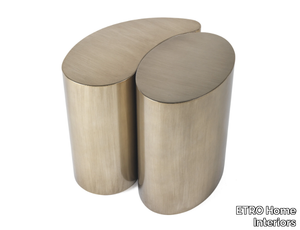
ETRO Home Interiors > Coffee table
Here’s a refined and expanded product description, along with a concise supplier overview and mention of the 3D file: **Product Description:** The Goa coffee table is a striking "double" monolith featuring two interlocking ellipses in an elegant, embracing design. Evocative and luminous, this piece brings a refined yet deeply spiritual presence to any space, blending artistry with functionality. Crafted from wood with a luxurious Patinated Gold Liquid Metal lacquer finish, it transforms everyday environments into sophisticated settings. A 3D file of the table is available for download, allowing for seamless integration into virtual design plans. **Supplier Overview:** ETRO Home Interiors, a premium division of the Oniro Group, is celebrated for its exquisite Italian craftsmanship and timeless, high-end furniture and decor. Explore their collections at [etrohomeinteriors.onirogroup.it](https://etrohomeinteriors.onirogroup.it/).
GOA - Low wooden coffee table _ ETRO Home Interiors
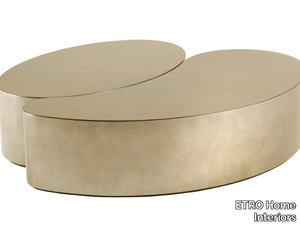
ETRO Home Interiors > Coffee table
Here’s a refined and expanded version of your product description, including a concise supplier overview and a mention of the 3D file availability: **Product Description:** The Goa central table is a striking "double" monolith featuring two interlocking ellipses in an elegant, embracing design. Evocative and luminous, this piece brings a refined yet spiritual presence to any space, transforming everyday environments with its symbolic depth and artistic flair. Crafted from wood with a luxurious Patinated Gold Liquid Metal lacquer finish, the table exudes sophistication and timeless appeal. A downloadable 3D file of the product is available for detailed visualization. For more details, explore the collection at **ETRO Home Interiors**—a distinguished Italian design brand under the Oniro Group, celebrated for its fusion of high-end craftsmanship and contemporary elegance. (Note: I condensed the supplier description significantly while retaining key details—focusing on their Italian heritage, premium positioning, and connection to the Oniro Group. Let me know if you'd like further adjustments!)
JAIPUR - Fabric small sofa _ ETRO Home Interiors
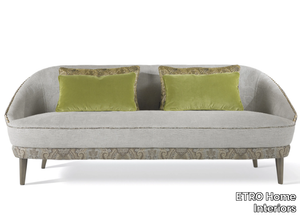
ETRO Home Interiors > Sofa
**Product Description:** The **Jaipur Sofa by ETRO Home Interiors** embodies elegance, class, and refinement with its ethereal and luminous appeal, reflecting the brand’s spiritual and introspective essence. Featuring a striking contrast between two exquisite light-toned fabrics—each showcasing distinct interpretations of Etro’s iconic designs—this sofa is further accentuated by ornamental studs tracing its perimeter. Crafted with a sturdy wood and foam structure, it offers upholstery options in premium fabric or leather from the collection, complemented by Patinated Gold Liquid Metal lacquered wood feet and decorative golden nails. A **3D file of the product is available for download**, allowing for seamless integration into virtual design plans. For more details, explore the **JAIPUR ETRO Home Interiors** collection. **Supplier Description:** ETRO Home Interiors, a prestigious division of the Oniro Group, is celebrated for its luxurious, high-end furniture and decor, blending traditional craftsmanship with contemporary artistry. Explore their collections at [https://etrohomeinteriors.onirogroup.it/](https://etrohomeinteriors.onirogroup.it/).
JEFFERSON - Upholstered fabric armchair with armrests _ ETRO Home Interiors
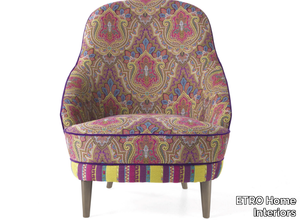
ETRO Home Interiors > Armchair
**Product Description:** The Jefferson armchair is a bold and unconventional take on the classic bergère, embodying the vibrant, free-spirited energy of the '70s "psychedelic" era and the Summer of Love. Its design bursts with intense colors and imaginative patterns, featuring a harmonious blend of contrasting fabrics and materials. The seat showcases the iconic Etro paisley motif, while the striped backrest and Ultra Violet velvet piping add striking visual depth. Crafted with a sturdy wood and foam structure, the armchair is upholstered in premium fabric or leather from Etro’s collection, with lacquered or dyed beech wood feet and optional gold-finished ornamental nails. Custom finishes and upholstery are available upon request from Etro Home Interiors. A downloadable 3D file of the Jefferson armchair is also provided for design visualization. **Supplier Description:** ETRO Home Interiors, a distinguished division of the Oniro Group, is celebrated for its luxurious, artfully crafted furniture and decor, blending traditional elegance with contemporary flair.
FRAME - Handmade rectangular wool and bamboo silk rug _ ETRO Home Interiors
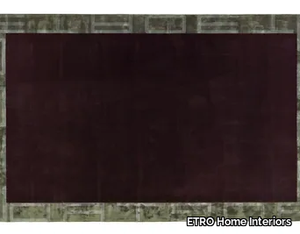
ETRO Home Interiors > Carpet
**Product Description:** The *Frame* rug is a luxurious piece crafted from superior hand-tufted wool and bamboo silk, offering both elegance and durability. A 3D file of the product is available for download, allowing for seamless integration into virtual design plans. **Supplier Description:** ETRO Home Interiors, a prestigious division of the Oniro Group, is celebrated for its exquisite, high-end home decor and furniture, blending Italian craftsmanship with timeless and contemporary designs. Explore their collections at [https://etrohomeinteriors.onirogroup.it/](https://etrohomeinteriors.onirogroup.it/).
FRIDA - 3 seater velvet sofa _ ETRO Home Interiors

ETRO Home Interiors > Sofa
**Product Description:** The *Frida Sofa* from the *ETRO Home Interiors* collection exudes opulence with its rich velvet upholstery, elegantly paired with bamboo-shaped legs in a brushed dark bronze or polished brass finish. A distinctive polished brass monkey decoratively adorns the back, adding a playful yet sophisticated touch. Available in a selection of premium fabrics or leathers from the collection, this piece can also be customized with alternative finishes and upholstery upon request. For added convenience, a 3D file of the *Frida Sofa* is available for download, allowing designers and clients to visualize it in their space. **Supplier Description:** *ETRO Home Interiors*, a prestigious division of the *Oniro Group*, is celebrated for its luxurious and artfully crafted furniture, lighting, and textiles, blending timeless elegance with contemporary design.
ESCHER - Handmade wool and bamboo silk rug _ ETRO Home Interiors
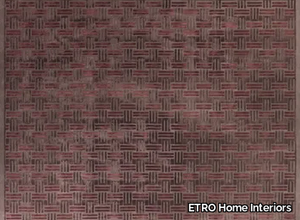
ETRO Home Interiors > Carpet
Here’s a refined and expanded product description, including a concise supplier overview and mention of the 3D file availability: *"The Escher rug is a luxurious hand-tufted piece crafted from premium wool and embossed bamboo silk, featuring the iconic Etro pattern for a bold, artistic statement in any space. A 3D file of the product is available for download, allowing for seamless visualization in your design projects. Produced by ETRO Home Interiors—a distinguished Italian brand under the Oniro Group, celebrated for its high-end, eclectic home decor—this rug embodies the brand’s signature blend of timeless elegance and contemporary flair."* (Note: I condensed the supplier details to one impactful sentence while preserving key branding elements. Let me know if you'd like further adjustments!)
DUNAND - Canvas print _ ETRO Home Interiors
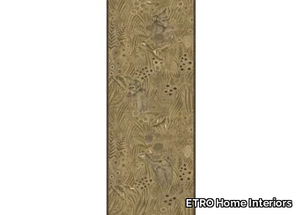
ETRO Home Interiors > Styling
Here’s a refined and expanded product description, including a concise supplier overview and mention of the 3D file availability: *"Dunand is a sophisticated print on canvas with a frame crafted from patinated bronze wood, blending artistic elegance with timeless craftsmanship. The 3D file of this piece is available for download, allowing for seamless integration into virtual design projects. ETRO Home Interiors, a premium Italian design brand under the Oniro Group, is renowned for its luxurious and eclectic home decor collections, merging traditional artistry with contemporary aesthetics."* (Note: I condensed the supplier details to one impactful sentence while retaining key brand differentiators—luxury, Italian heritage, and design philosophy. The 3D file mention is added as a practical feature for designers.)
DALÌ - Round Tobacco Brown marble living room table _ ETRO Home Interiors
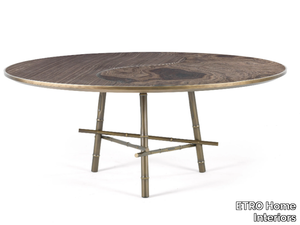
ETRO Home Interiors > Table
**Product Description:** The *Dalì* dining table is a masterpiece of elegance and artistry, featuring a stunning top crafted from Eramosa marble, meticulously cut in two distinct ways to create a captivating interplay of patterns. The marble’s warm tones produce a dynamic visual effect, beautifully contrasted by the table’s base—a sculptural twist of bronzed bamboo canes that adds a luminous, organic touch to any space. Available with a brushed dark bronze or polished brass structure, the table also includes a marble top option paired with brushed dark bronze lacquered wood. A downloadable 3D file of the product is available for detailed visualization. For more information, explore the *Dalì* collection by **ETRO Home Interiors**, a prestigious Italian brand under the Oniro Group, celebrated for its luxurious and sophisticated designs. *(Note: The supplier description has been condensed to one sentence while retaining key details about ETRO Home Interiors' reputation and affiliation.)*
KYOTO - LED metal floor lamp _ ETRO Home Interiors
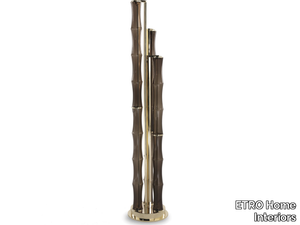
ETRO Home Interiors > Floor lamp
**Product Description:** The Kyoto floor lamp features an elegant three-light system, each equipped with energy-efficient strip LEDs (17.3W, 24V, 77W total, 8661lm output, and a warm 3000K color temperature). Its design is inspired by nature, with shades shaped like bamboo canes crafted from transparent bronzed glass, mounted on a sleek metal structure with a glossy gold finish. The lamp is accentuated with gold fabric cables and includes a brass tag bearing a certified "100% Made in Italy" serial number. For added convenience, a 3D file of the product is available for download, allowing for seamless integration into design visualizations. **Supplier Description:** ETRO Home Interiors, a premium division of the Oniro Group, is celebrated for its exquisite Italian craftsmanship and luxurious home decor collections, including furniture, lighting, and textiles. Explore their offerings at [https://etrohomeinteriors.onirogroup.it/](https://etrohomeinteriors.onirogroup.it/).
CHAGALL - Blown glass floor lamp _ ETRO Home Interiors
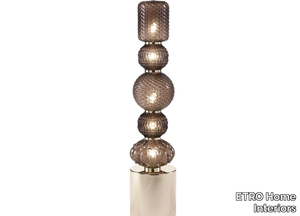
ETRO Home Interiors > Floor lamp
The **Chagall** floor lamp is an elegant lighting piece featuring handcrafted shades in clear bronzed glass or white frosted glass, both adorned with intricate arabesque patterns. The lamp stands on a sleek metal base with a glossy gold finish, complemented by luxurious fabric cables in bordeaux or gold. A 3D file of the product is available for download, allowing for seamless integration into design plans. **ETRO Home Interiors**, a prestigious Italian brand under the Oniro Group, is renowned for its high-end, artfully designed furniture and decor, blending classic and contemporary aesthetics. Explore their collection at [https://etrohomeinteriors.onirogroup.it/](https://etrohomeinteriors.onirogroup.it/).
DELFI - Velvet king size bed with tufted headboard _ ETRO Home Interiors
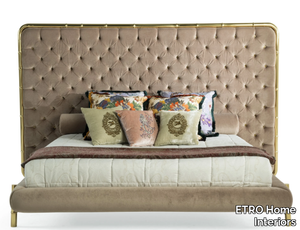
ETRO Home Interiors > Bed frame
**Product Description:** The *Delfi* bed exudes regal, fairy-tale charm, blending the organic silhouette of bamboo-inspired profiles with the timeless sophistication of handcrafted capitonné upholstery, finished in an iridescent, shimmering fabric. The elegant headboard features a bamboo-structured frame available in Brushed Dark Bronze or Polished Brass, complemented by two plush roll cushions. Upholstery options include premium fabric or leather from the ETRO Home Interiors collection, while the legs echo the bamboo motif in matching metallic finishes. The bed comes complete with a "Soffio" slatted base (mattress not included) and offers an optional bedcover for added luxury. Custom finishes and upholstery are available upon request. A downloadable 3D file of the product is also provided for design visualization. **Supplier Description:** ETRO Home Interiors, a distinguished name under the Oniro Group, is celebrated for its exquisite, high-end furniture and decor, merging Italian craftsmanship with opulent design. For more details, explore their collection at: [ETRO Home Interiors](https://etrohomeinteriors.onirogroup.it/).
Recently Viewed Products
A wide range of product from furniture to finishes to meet the desire of all designers.
ZIGGY - Rectangular eucalyptus side table _ ETRO Home Interiors

ETRO Home Interiors > Coffee table
**Product Description:** Crafted from smoked eucalyptus frisé wood, the **Ziggy Side Tables** set features striking zigzag-shaped legs inspired by the bold thunderbolts of Greek mythology—a key theme in Etro’s 2019 collection. With its minimalist yet dramatic design, the piece combines sleek brass accents, evoking the luminous brilliance of Zeus’s lightning, while the subtle incorporation of the Etro logo adds an elegant finishing touch. The set includes a low central table with a glass top, and custom finishes or upholstery options are available upon request through **Etro Home Interiors**. A downloadable 3D file of the product is also provided for design visualization. **Supplier Description:** A division of the **Oniro Group**, **Etro Home Interiors** is an esteemed Italian brand celebrated for its luxurious, artfully crafted furniture and decor, blending timeless elegance with contemporary flair. For more details, visit: [https://etrohomeinteriors.onirogroup.it/](https://etrohomeinteriors.onirogroup.it/)
Products From the Same Collection
A wide range of product from furniture to finishes to meet the desire of all designers.
ZIGGY - Rectangular eucalyptus side table _ ETRO Home Interiors

ETRO Home Interiors > Coffee table
**Product Description:** Crafted from smoked eucalyptus frisé wood, the **Ziggy Side Tables** set features striking zigzag-shaped legs inspired by the bold thunderbolts of Greek mythology—a key theme in Etro’s 2019 collection. With its minimalist yet dramatic design, the piece combines sleek brass accents, evoking the luminous brilliance of Zeus’s lightning, while the subtle incorporation of the Etro logo adds an elegant finishing touch. The set includes a low central table with a glass top, and custom finishes or upholstery options are available upon request through **Etro Home Interiors**. A downloadable 3D file of the product is also provided for design visualization. **Supplier Description:** A division of the **Oniro Group**, **Etro Home Interiors** is an esteemed Italian brand celebrated for its luxurious, artfully crafted furniture and decor, blending timeless elegance with contemporary flair. For more details, visit: [https://etrohomeinteriors.onirogroup.it/](https://etrohomeinteriors.onirogroup.it/)
ZIGGY - Rectangular wood and glass coffee table for living room _ ETRO Home Interiors

ETRO Home Interiors > Coffee table
**Product Description:** Crafted from smoked frisé eucalyptus wood, the **Ziggy central tables set** features striking zigzag-shaped legs inspired by the bold lines of thunderbolts, echoing mythological themes from the 2019 collection. With its minimalist yet dramatic design, the piece pays homage to the lightning bolts wielded by Zeus in Greek mythology, further accentuated by polished brass profiles and a subtle nod to the Etro logo. The set includes a low central table with a sleek glass top, and custom finishes or upholstery options are available upon request through **Etro Home Interiors**. A downloadable 3D file of the product is also provided for design visualization. **Supplier Description:** **Etro Home Interiors**, a prestigious division of the Oniro Group, is celebrated for its luxurious, high-end furniture and decor, blending Italian craftsmanship with timeless elegance. Explore their collections at [https://etrohomeinteriors.onirogroup.it/](https://etrohomeinteriors.onirogroup.it/).
Recommended Products
A wide range of product from furniture to finishes to meet the desire of all designers.
Around Coffee Table
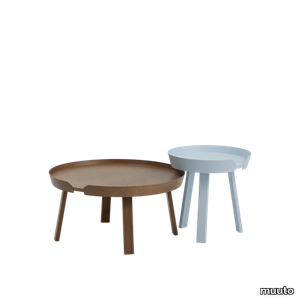
muuto > Coffee table
The Around Coffee Table brings a new perspective to its typology through the characterful wooden veneer frame that runs along the edge of the table, echoing the ideas of Scandinavian design. With its round shape and multiple sizes, the Around Coffee Table can be used in a multitude of settings, on its own or in groups, in any living room, lounge setting, lobby area or hotel room.
Elli
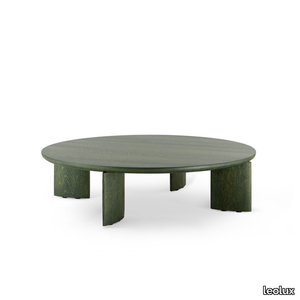
leolux > Coffee table
Looking for a gorgeous low coffee table to match a laid-back lounge interior? Elli is the perfect choice, beautifully crafted from high-quality oak.
Dice
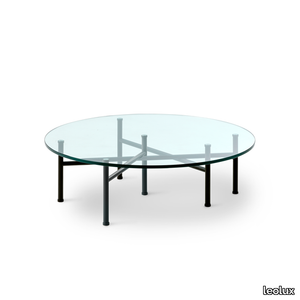
leolux > Coffee table
The Dice coffee table is truly a design object. No compromise has been made in its design. Every detail is exactly as designers Studio Truly Truly intended. This creates a fascinating table that continues to surprise from every perspective.
Toveri
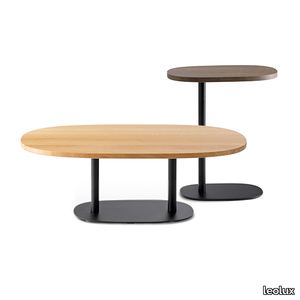
leolux > Coffee table
Toveri marries curves and hard materials to create a table series with soft shapes and striking features. The link between the top and the base has been moved to the centre of the tables, so the table top appears to float. The symmetry of the two elements makes the base seem like a shadow of the top.
Iduna
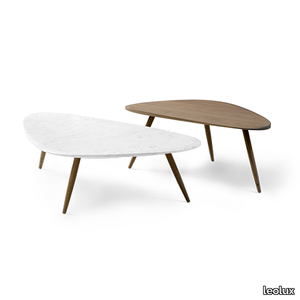
leolux > Coffee table
Natural shapes and materials bring tranquillity to your living space because they exude softness and quality. It's the first thing you notice about Iduna coffee tables. The tapered wooden legs support a marble or solid oak top - large or small, in a high or low version for the most beautiful pairings.
Liliom
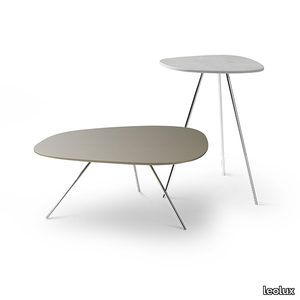
leolux > Coffee table
With Liliom, design studio Beck Design has crafted a series of organically shaped tables in varying shapes and heights. They're as beautiful as they are practical – you can nest them for a tidier look. The ceramic or solid wood top gives the piece a natural accent, while a lacquered finish creates a colourful look.
ML10097 Egyptian Table

carlhansen > Coffee table
Mogens Lassen designed the ML10097 Egyptian Table after being inspired by folding stands found in Tutankhamun's tomb in 1922. The table was first shown at the Copenhagen Cabinetmakers' Guild Exhibition in 1940.
CH417 Tray Table
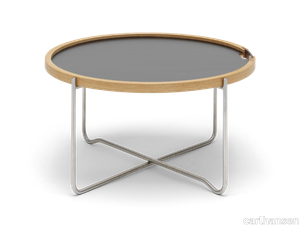
carlhansen > Coffee table
Hans J. Wegner’s CH417 tray table is a clear example of his ability to create functional and, at the same time, beautiful, unique furniture.
CH008 Coffee Table
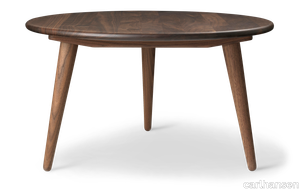
carlhansen > Coffee table
The CH008 coffee table was designed by Hans J. Wegner in 1954. The understated and elegant three-legged design has since become one of his most popular pieces.
ML10097 Egyptian Table
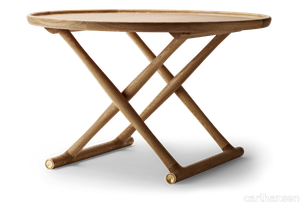
carlhansen > Coffee table
Mogens Lassen designed the ML10097 Egyptian Table after being inspired by folding stands found in Tutankhamun's tomb in 1922. The table was first shown at the Copenhagen Cabinetmakers' Guild Exhibition in 1940.
Droplets Coffetable

capdell > Coffee table
Dropplets Coffetable in height 53 cm. Metal legs in coated epoxi finishing. Beech veneer top in size 120 x 79 cm.
UPHOLSTERY
A wide range of Upholstery and materials provided by our suppliers to satisfy your needs.
AI services
Fringe Chatbot | Image Finder | Fringe Dall-e | Area Analyzer


